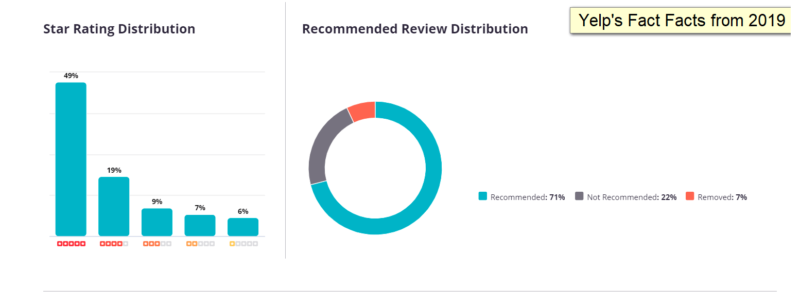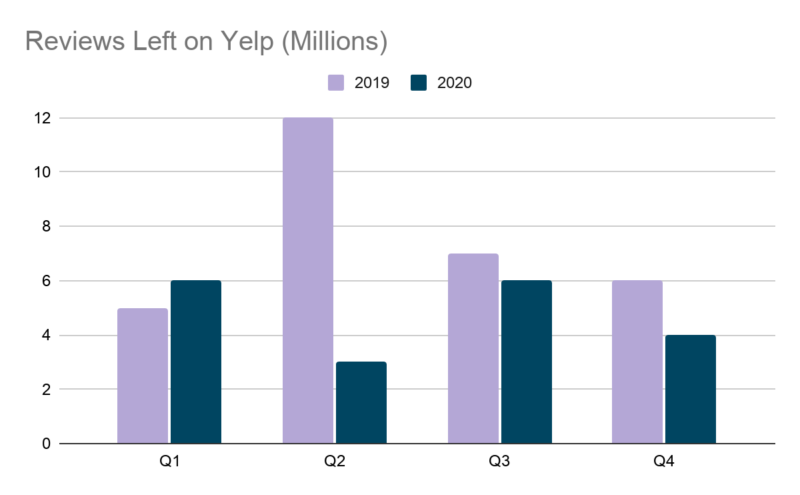Online reviews have a crucial impact on small businesses. Most businesses strive for a solid online reputation, which means investing time and money in monitoring these reviews across citation listings. It’s worth the effort, though. Proactive online reputation management helps build trust with potential and returning customers. Plus, reviews help your visibility in local search, and lines from your list of reviews can even show up in your Google My Business listing, too. Here’s a list of the latest trends in online reviews to keep your business in the loop in 2021:
More users are leaving 1- and 5-star reviews and fewer are leaving 2-3 stars.
According to 2020 stats based on reviews left on Yelp’s platform, over half (51%) were 5-star reviews. Compared to 5 years earlier, the percentage of 5-star and 1-star reviews is growing, and everything in between is shrinking.

It’s been a common refrain for most businesses who solicit online reviews. People usually only take to Yelp, GMB, or Facebook reviews when they’re either very pleased or quite disgruntled. The changing distribution of middle star reviews means that it’s more critical than ever for businesses to create a review program to solicit a larger volume of reviews from people who may not have thought to leave one before. While it’s against the terms of service for most platforms to solicit only positive reviews, asking all your customers to rate your business is not against the rules.
Fewer people are reporting that they “trust reviews as much as personal recommendations.”
In BrightLocal’s 2020 edition of their annual survey to over 1,000 users in the US, 79% of consumers say they trust online reviews as much as personal recommendations from friends or family. However, if we look at the overall trend, we can see that 10% fewer respondents trust online reviews compared to 2014.

Another study from Reviews.com corroborated this trend with 38.5% of people polled saying they trust reviews less than they did 5 years ago.
This trend can be a double-edged sword. Users are more web-savvy than ever, and they can tell when there are suspicious patterns in reviews–like when a business has all 5-star reviews that were submitted all within the same time period. However, it also means that consumers can sort through potentially negative or fake reviews as one-offs when one or two individuals were perhaps having a bad day and took it out on your business.
Overall, while trust in online reviews is trending downward, the number of people who still trust what others are saying about your business is pretty high at almost 80%.
We’re seeing an increase in fake reviews.
Again, looking at Yelp’s data from 2020, it shows they removed 8% of reviews since Yelp’s inception. Reviews get removed when they are found to violate Yelp’s policies. In 2019, this number was 7% so over time it appears this is increasing (below is a screenshot of what their site said in 2019.

In this report by the FTC, Devesh Raval concludes “I estimated that about half of the difference between Google and Yelp ratings of low-quality businesses are due to fake reviews, and at least about a quarter of Google reviews for low-quality businesses are likely fake.”
Fake reviews are considered those left by employees, business owners, customers who are lying, vendors, and former employees. It’s important that review platforms like Yelp and Google My Business review and remove these types of fake reviews to not pollute the experience of actual customers and the effectiveness of existing reviews.
Fewer reviews were left in the last year due to COVID-19.
Recently, in their yearly spam report, Google stated, “We saw a drop in the overall number of reviews due to fewer people being out and about during COVID-19”. I noticed the same pattern when I looked at Yelp’s data. When comparing the differences in cumulative review counts over the last couple of years there was a clear drop in the number of reviews left in the last 3 quarters of 2020.

COVID has changed the way review services have functioned over the past year alone. Google paused review services at the beginning of the pandemic due to confusion and communication issues surrounding safety procedures. Many customers were understandably confused when a business listing said they were open but, upon arrival, the customer found out the business was closed or had limited services. The measure from Google helped prevent negative reviews related to this confusion that could harm small businesses who were caught up in the constantly changing protocols.
Yelp also adjusted its review service options this year, allowing customers to leave reviews about how a business follows COVID-related health and safety measures.
Why we care. As reviews continue to be a huge influencer on purchasing behavior online, it’s crucial to know how the various platforms are combatting the issues with fake reviews and how consumers are responding. With reviews still believed to be a local SEO ranking factor, it’s important for businesses to not ignore the importance that reviews still have in the local pack–even if customer sentiment regarding reviews is slowly shifting, especially with the pandemic. The data also proves that it’s more important than ever for small businesses to implement a review solicitation strategy that follows each platform’s terms of service.
Opinions expressed in this article are those of the guest author and not necessarily Search Engine Land. Staff authors are listed here.

